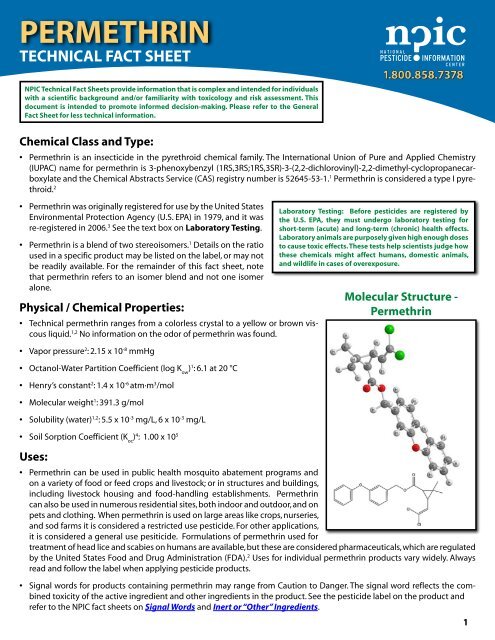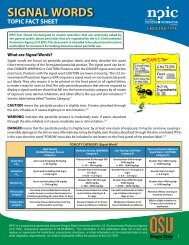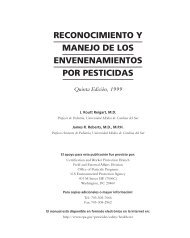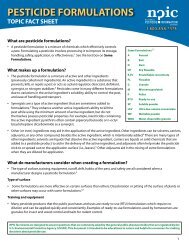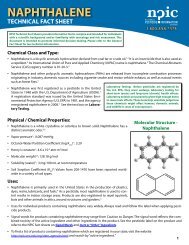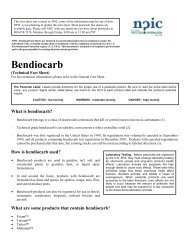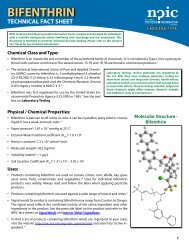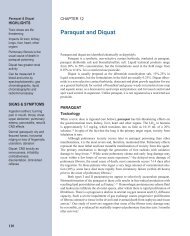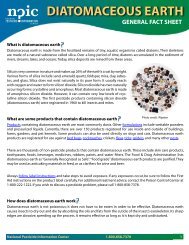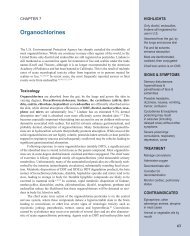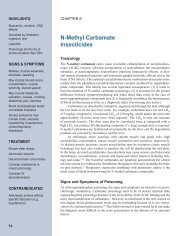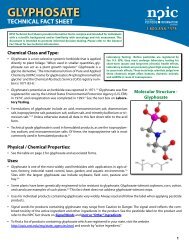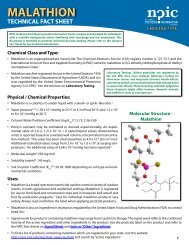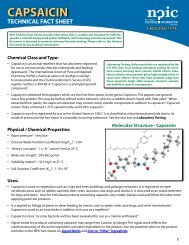Permethrin - National Pesticide Information Center - Oregon State ...
Permethrin - National Pesticide Information Center - Oregon State ...
Permethrin - National Pesticide Information Center - Oregon State ...
You also want an ePaper? Increase the reach of your titles
YUMPU automatically turns print PDFs into web optimized ePapers that Google loves.
PERMETHRIN<br />
TECHNICAL FACT SHEET<br />
Chemical Class and Type:<br />
• <strong>Permethrin</strong> is an insecticide in the pyrethroid chemical family. The International Union of Pure and Applied Chemistry<br />
(IUPAC) name for permethrin is 3-phenoxybenzyl (1RS,3RS;1RS,3SR)-3-(2,2-dichlorovinyl)-2,2-dimethyl-cyclopropanecarboxylate<br />
and the Chemical Abstracts Service (CAS) registry number is 52645-53-1. 1 <strong>Permethrin</strong> is considered a type I pyrethroid.<br />
2<br />
• <strong>Permethrin</strong> was originally registered for use by the United <strong>State</strong>s<br />
Environmental Protection Agency (U.S. EPA) in 1979, and it was<br />
re-registered in 2006. 3 See the text box on Laboratory Testing.<br />
1 • <strong>Permethrin</strong> is a blend of two stereoisomers. Details on the ratio<br />
used in a specific product may be listed on the label, or may not<br />
be readily available. For the remainder of this fact sheet, note<br />
that permethrin refers to an isomer blend and not one isomer<br />
alone.<br />
Physical / Chemical Properties:<br />
•<br />
•<br />
Technical permethrin ranges from a colorless crystal to a yellow or brown viscous<br />
liquid. 1,2 No information on the odor of permethrin was found.<br />
2 -8 Vapor pressure : 2.15 x 10 mmHg<br />
• Octanol-Water Partition Coefficient (log Kow<br />
)1 : 6.1 at 20 °C<br />
•<br />
•<br />
•<br />
NPIC Technical Fact Sheets provide information that is complex and intended for individuals<br />
with a scientific background and/or familiarity with toxicology and risk assessment. This<br />
document is intended to promote informed decision-making. Please refer to the General<br />
Fact Sheet for less technical information.<br />
2 -6 3 Henry’s constant : 1.4 x 10 atm·m /mol<br />
1 Molecular weight : 391.3 g/mol<br />
1,2 -3 -3 Solubility (water) : 5.5 x 10 mg/L, 6 x 10 mg/L<br />
• Soil Sorption Coefficient (Koc<br />
)4 : 1.00 x 105 Uses:<br />
Laboratory Testing: Before pesticides are registered by<br />
the U.S. EPA, they must undergo laboratory testing for<br />
short-term (acute) and long-term (chronic) health effects.<br />
Laboratory animals are purposely given high enough doses<br />
to cause toxic effects. These tests help scientists judge how<br />
these chemicals might affect humans, domestic animals,<br />
and wildlife in cases of overexposure.<br />
Molecular Structure -<br />
<strong>Permethrin</strong><br />
• <strong>Permethrin</strong> can be used in public health mosquito abatement programs and<br />
on a variety of food or feed crops and livestock; or in structures and buildings,<br />
including livestock housing and food-handling establishments. <strong>Permethrin</strong><br />
can also be used in numerous residential sites, both indoor and outdoor, and on<br />
pets and clothing. When permethrin is used on large areas like crops, nurseries,<br />
and sod farms it is considered a restricted use pesticide. For other applications,<br />
it is considered a general use pesiticide. Formulations of permethrin used for<br />
treatment of head lice and scabies on humans are available, but these are considered pharmaceuticals, which are regulated<br />
by the United <strong>State</strong>s Food and Drug Administration (FDA). 2 Uses for individual permethrin products vary widely. Always<br />
read and follow the label when applying pesticide products.<br />
• Signal words for products containing permethrin may range from Caution to Danger. The signal word reflects the combined<br />
toxicity of the active ingredient and other ingredients in the product. See the pesticide label on the product and<br />
refer to the NPIC fact sheets on Signal Words and Inert or “Other” Ingredients.<br />
1
PERMETHRIN<br />
TECHNICAL FACT SHEET<br />
•<br />
To find a list of products containing permethrin which are registered in your state, visit the website<br />
http://npic.orst.edu/reg/state_agencies.html and search by “active ingredient.”<br />
Mode of Action:<br />
Target Organisms<br />
• <strong>Permethrin</strong> acts on the nervous system of insects. It interferes with sodium channels to disrupt the function of neurons,<br />
and causes muscles to spasm, culminating in paralysis and death. 1,2<br />
•<br />
<strong>Permethrin</strong> can be effective by contact or ingestion and also acts as a mild repellent.<br />
Non-target Organisms<br />
•<br />
<strong>Permethrin</strong> is highly toxic to honeybees, fish, and aquatic invertebrates due to disruption of sodium channels.<br />
• In general, mammals are less susceptible to permethrin compared to insects because their sodium channels are less sensitive<br />
to pyrethroids and recover more rapidly. Also, because of their larger body size and greater metabolic capabilities,<br />
mammals are more likely to metabolize pyrethroids, such as permethrin, before they can affect the nervous system. 5,6 Conversely,<br />
cats can be sensitive to products with high concentrations of permethrin, possibly due to insufficient glucoronide<br />
conjugation capability, which hinders the metabolism of permethrin. 7,8<br />
Acute Toxicity:<br />
Oral<br />
• In rat studies, permethrin LD values range from 430-4000 mg/<br />
50<br />
kg. <strong>Permethrin</strong> LD values for mice range from 540-2690 mg/<br />
50<br />
kg. Factors contributing to the variability of these values include<br />
age, sex, carrier and isomer ratio. 1<br />
• The U.S. EPA considered permethrin to be low in toxicity for<br />
acute oral exposure based on an acute oral LD range of 2280-<br />
50<br />
3580 mg/kg in rats. 2 See the text boxes on Toxicity Classification<br />
and LD /LC .<br />
50 50<br />
Dermal<br />
• The dermal LD for permethrin in rabbits is over 2000 mg/kg. The U.S. EPA considered permethrin to be low in toxicity for<br />
50<br />
acute dermal expsoure. 2,9<br />
• <strong>Permethrin</strong> is considered to be low in toxicity for potential eye irritation and very low in toxicity for potential skin irritation.<br />
All irritation in test rabbits cleared within 48 hours for dermal exposures and 72 hours for ocular exposures. 2 <strong>Permethrin</strong> is<br />
not considered a skin sensitizer. 2,9<br />
Inhalation<br />
• One study found a 4-hour inhalation LC50<br />
in rats greater than 23.5 mg/L.9 However, the U.S. EPA recognizes this area as a<br />
“data gap” and is seeking acute inhalation toxicity data for permethrin. 2<br />
Signs of Toxicity - Animals<br />
• Dermal exposures to cats and dogs may cause temporary paresthesia and neurological signs as evidenced by paw flicking<br />
or ear, tail or skin twitching, or rolling on the ground. 5<br />
1<br />
1,3,5<br />
LD 50 /LC 50 : A common measure of acute toxicity is the lethal<br />
dose (LD 50 ) or lethal concentration (LC 50 ) that causes death<br />
(resulting from a single or limited exposure) in 50 percent<br />
of the treated animals. LD 50 is generally expressed as the<br />
dose in milligrams (mg) of chemical per kilogram (kg) of<br />
body weight. LC 50 is often expressed as mg of chemical<br />
per volume (e.g., liter (L)) of medium (i.e., air or water) the<br />
organism is exposed to. Chemicals are considered highly<br />
toxic when the LD 50 /LC 50 is small and practically non-toxic<br />
when the value is large. However, the LD 50 /LC 50 does not<br />
reflect any effects from long-term exposure (i.e., cancer,<br />
birth defects or reproductive toxicity) that may occur at<br />
levels below those that cause death.<br />
2
PERMETHRIN<br />
TECHNICAL FACT SHEET<br />
TOXICITY CLASSIFICATION - PERMETHRIN<br />
High Toxicity Moderate Toxicity Low Toxicity Very Low Toxicity<br />
Acute Oral<br />
LD<br />
50<br />
Up to and including 50 mg/kg<br />
(≤ 50 mg/kg)<br />
Greater than 50 through 500<br />
mg/kg<br />
(> 50 – 500 mg/kg)<br />
Greater than 500 through<br />
5000 mg/kg<br />
(> 500 – 5000 mg/kg)<br />
Greater than 5000 mg/kg<br />
(> 5000 mg/kg)<br />
Inhalation<br />
LC<br />
50<br />
Up to and including 0.05 mg/L<br />
(≤ 0.05 mg/L)<br />
Greater than 0.05 through<br />
0.5 mg/L<br />
(>0.05 – 0.5 mg/L)<br />
Greater than 0.5 through 2.0<br />
mg/L<br />
(> 0.5 – 2.0 mg/L)<br />
Greater than 2.0 mg/L<br />
(> 2.0 mg/L)<br />
Dermal<br />
LD<br />
50<br />
Up to and including 200 mg/kg<br />
(≤ 200 mg/kg)<br />
Greater than 200 through<br />
2000 mg/kg<br />
(> 200 - 2000 mg/kg)<br />
Greater than 2000 through<br />
5000 mg/kg<br />
(>2000 – 5000 mg/kg)<br />
Greater than 5000 mg/kg<br />
(> 5000 mg/kg)<br />
Primary Eye<br />
Irritation<br />
Corrosive (irreversible destruction of<br />
ocular tissue) or corneal involvement or<br />
irritation persisting for more than 21 days<br />
Corneal involvement or other<br />
eye irritation clearing in 8 –<br />
21 days<br />
Corneal involvement or other<br />
eye irritation clearing in 7<br />
days or less<br />
Minimal effects clearing in<br />
less than 24 hours<br />
Primary Skin<br />
Irritation<br />
Corrosive (tissue destruction into the<br />
dermis and/or scarring)<br />
Severe irritation at 72 hours<br />
(severe erythema or edema)<br />
Moderate irritation at 72<br />
hours (moderate erythema)<br />
Mild or slight irritation at<br />
72 hours (no irritation or<br />
erythema)<br />
The highlighted boxes relfect the values in the “Acute Toxicity” section of this fact sheet. Modeled after the U.S. Environmental Protection<br />
Agency, Office of <strong>Pesticide</strong> Programs, Label Review Manual, Chapter 7: Precautionary Labeling. http://www.epa.gov/oppfead1/labeling/lrm/chap-07.pdf<br />
• Cats exposed dermally to some permethrin products may experience hyperexcitability, depression, ataxia, vomiting, anorexia,<br />
tremors, or convulsions. Symptoms can begin within a few minutes or up to three days after the exposure. Some<br />
permethrin products contain high concentrations of the active ingredient and are labeled for use only on dogs. Close<br />
physical contact with a recently treated dog may also lead to symptoms in cats. If symptoms are severe and untreated, they<br />
may result in death. 5,7,10<br />
• A report of 11 cats intentionally treated with products containing 45-65% permethrin described adverse effects including<br />
muscle tremors, seizures, incoordination and agitation after exposure. Of the 11 cats that were treated, all were hospitalized,<br />
and four died after the exposure. Seizures were found to develop within 24 hours of exposure, with some cats experiencing<br />
seizures within two hours. In one additional case, a cat was in proximity of two large dogs treated with a permethrin<br />
product 48 hours after treatment. Between 18 and 24 hours after being near the dogs, the cat developed signs including<br />
agitation, tremors, seizures, and ataxia. 11<br />
•<br />
•<br />
Animals may also display drooling or lip-smacking. This is believed to be a result of licking at the application site and<br />
thought to be caused either by the taste or a tingling sensation in the mouth. 5<br />
Cattle which have been treated topically with permethrin may show signs of paresthesia including twitching the skin on<br />
their backs, trying to rub their backs, and general restlessness. 5<br />
Signs of Toxicity - Humans<br />
• Dermal exposure to permethrin may cause irritation, itching, or paresthesia (a tingly, prickly sensation) at the site of contact.<br />
These symptoms rarely last more than 24 hours. 12 Ocular exposures may result in pain, redness, or a burning sensation. 13<br />
•<br />
•<br />
12 While pyrethroids have been suggested as potential skin sensitizers , no human data were found to support this for permethrin.<br />
Ingestion of permethrin may cause sore throat, abdominal pain, nausea, and vomiting.<br />
6,13<br />
3
PERMETHRIN<br />
TECHNICAL FACT SHEET<br />
• Inhalation of permethrin may cause headache, nasal and respiratory irritation, difficulty breathing, dizziness, nausea or<br />
vomiting. 6,13 Because of permethrin’s low vapor pressure, inhalation exposures are more likely to result from aerosols, spray<br />
droplets, and dust, than from actual vapors. 6<br />
• Always follow label instructions and take steps to minimize exposure. If any exposure occurs, be sure to follow the First Aid<br />
instructions on the product label carefully. For additional treatment advice, contact the Poison Control <strong>Center</strong> at 1-800-<br />
222-1222. If you wish to report an incident to the <strong>National</strong> <strong>Pesticide</strong> <strong>Information</strong> <strong>Center</strong>, please call 1-800-858-7378.<br />
Chronic Toxicity:<br />
Animals<br />
• Dogs fed daily doses of permethrin at 0, 5, 50 or 500 mg/kg body weight<br />
per day for at least 96 days showed transient signs of permethrin toxicosis<br />
at the highest dose used, including tremors. Researchers determined<br />
the NOAEL to be 50 mg/kg per day for this study, based on<br />
increased liver weights and neurological effects. 9 See the text box on<br />
NOAEL, NOEL, LOAEL, and LOEL.<br />
• Mice were fed permethrin at concentrations ranging from 28 to 1400 mg/kg body weight per day for 28 days. No mice died<br />
during this experiment and no significant clinical signs were seen. Necropsies revealed an increase in liver weights relative<br />
to body weights in the 280 and 1400 dose groups. Researchers determined the NOAEL at 140 mg/kg per day based on the<br />
doses used in this study. 9<br />
•<br />
Rabbits given 21 daily dermal doses of permethrin ranging from 0.10 to 1.0 g/kg body weight showed signs of skin irritation,<br />
but no additional signs of toxicity were observed. 14<br />
• Guinea pigs, dogs, and rats were exposed to aerosolized permethrin for 13 weeks, five days per week, six hours each day.<br />
Concentration levels used in the experiment were 125, 250, and 500 mg/m3 . At the highest dose tested, rats experienced<br />
tremors and convulsions in the first week only. The guinea pigs and dogs exhibited no clinical signs of poisoning throughout<br />
the experiment. 14<br />
•<br />
Rats involved in a 2-year feeding study were given 100 mg/kg permethrin in their diet. These rats showed no signs of toxic-<br />
ity. 1<br />
Humans<br />
• The U.S. EPA has determined a reference dose (RfD) and a Population Adjusted Dose (PAD) of 0.25 mg/kg/day for both<br />
acute and chronic dietary exposures to permethrin. These levels are based on a NOAEL of 25 mg/kg/day in rats and an<br />
Uncertainty Factor (UF) of 100. 2 See the text box on Reference Dose (RfD) (page 8).<br />
• No human data were found on chronic effects of permethrin. See the text box on Exposure.<br />
Endocrine Disruption:<br />
•<br />
NOAEL: No Observable Adverse Effect Level<br />
NOEL: No Observed Effect Level<br />
LOAEL: Lowest Observable Adverse Effect Level<br />
LOEL: Lowest Observed Effect Level<br />
Exposure: Effects of permethrin on human health and the environment depend on how much<br />
permethrin is present and the length and frequency of exposure. Effects also depend on the<br />
health of a person and/or certain environmental factors.<br />
Experiments with rat and human cancer cell lines indicated that permethrin did not act as an antagonist for estrogens or<br />
androgens, nor did it act as an agonist for estrogens or androgens.<br />
4<br />
15,16 It was also concluded that permethrin did not act
PERMETHRIN<br />
TECHNICAL FACT SHEET<br />
as a progestin in human cancer cells. 15,16 However, other research on human cancer cell lines implied a potential for permethrin<br />
to interfere with estrogenic activity through interface with the progesterone receptor. 17 More research is required<br />
to better understand any possible link between permethrin and endocrine function.<br />
• <strong>Permethrin</strong> is included in the draft list of initial chemicals for screening under the U.S. EPA Endocrine Disruptor Screening<br />
Program (EDSP). The list of chemicals was generated based upon exposure potential, not based on whether the pesticide<br />
is a known or likely potential cause of endocrine effects. 18<br />
Carcinogenicity:<br />
Animals<br />
• Rats fed diets containing 500, 1000, or 2500 ppm for a period of two years showed no signs of carcinogenicity, however,<br />
signs of toxicity were noted at the highest doses used. 19<br />
• A lifetime cancer study involving mice fed diets with 250, 1000, or 2500 ppm permethrin resulted in slightly elevated numbers<br />
of benign hepatic tumors in males at the highest dose tested although the effect was not statistically significantly<br />
different from controls. 19<br />
Humans<br />
• In 1991, the International Agency for Research on Cancer (IARC) classified permethrin as Group 3, “not classifiable as to its<br />
carcinogenicity to humans”, due to a lack of evidence. 20 More recently, the U.S. EPA has classified permethrin as “likely to<br />
be carcinogenic to humans” by ingestion. This rating is based on benign lung and liver tumors found in mice and similar,<br />
though inconclusive, evidence in rats, as well as corroborative Structure-Activity Relationships (SAR) information. 2 See the<br />
text box on Cancer.<br />
•<br />
No human data were found on the carcinogenic effects of permethrin.<br />
Reproductive or Teratogenic Effects:<br />
Animals<br />
• Researchers studied the potential developmental effects of oral exposure to permethrin in pregnant rats. At a dose of 150<br />
mg/kg body weight per day of pregnancy, researchers observed a reduction in fetal rat weights and a greater occurrence<br />
of additional ribs in the developing fetuses. No adverse effects were noted at 50 mg/kg body weight per day, the next lowest<br />
dose. 21<br />
• A similar study examined the effects of oral permethrin exposures on the offspring of pregnant rabbits. At 1200 mg/kg body<br />
weigh per day of gestation, rabbits exhibited a greater loss of developing fetuses and decreased ossification of hind- and<br />
fore-limbs of the fetuses. No adverse effects were observed at the next lowest dose, 600 mg/kg body weight per day. 21<br />
Humans<br />
• A study was conducted involving 196 women who had applied a single, full-body, dermal dose of 4% permethrin as a<br />
scabies treatment during their second or third trimesters of pregnancy. Researchers found no evidence that exposure to<br />
permethrin affected the outcome of the participants’ pregnancies. 22<br />
•<br />
Cancer: Government agencies in the United <strong>State</strong>s and abroad have developed programs to evaluate the<br />
potential for a chemical to cause cancer. Testing guidelines and classification systems vary. To learn more<br />
about the meaning of various cancer classification descriptors listed in this fact sheet, please visit the<br />
appropriate reference, or call NPIC.<br />
A study involving 113 women using a 1% permethrin head lice treatment during pregnancy found no indication that exposure<br />
to permethrin affected the outcome of their pregnancies.<br />
5<br />
23
PERMETHRIN<br />
TECHNICAL FACT SHEET<br />
Fate in the Body:<br />
Absorption<br />
• Human case studies involving skin applications of permethrin indicated that about 0.5% of the applied dose was absorbed<br />
•<br />
•<br />
dermally. 24<br />
9 Animal studies showed quick and substantial absorption of permethrin upon ingestion. In one study of rats, about 60% of<br />
the orally administered dose was absorbed with an absorption half-life of less than one hour. 25<br />
No information was found regarding absorption rates following inhalation of permethrin.<br />
Distribution<br />
• Feeding studies using rats indicated that permethrin was rapidly distributed throughout the body. Peak concentrations<br />
measured in plasma, nerve tissue, liver, and kidneys occurred around four hours after ingestion. Levels found in nervous<br />
tissues were generally higher compared with in plasma. 25,26<br />
•<br />
A human case study involving an intentional ingestion of permethrin showed a similar distribution pattern with a peak<br />
permethrin concentration found in blood three to four hours after ingestion. 27<br />
Metabolism<br />
• In animal feeding studies using rats, goats, cows, and hens, permethrin was metabolized quickly in the liver. Hydrolysis,<br />
hydroxylation, oxidation, and conjugation are all involved in the process of metabolism. 9,28<br />
•<br />
While several metabolites of permethrin have been identified, permethrin itself is considered the only compound of toxicological<br />
significance. 2,9<br />
Excretion<br />
• <strong>Permethrin</strong> and its metabolites are excreted primarily in the urine, but also in the feces.<br />
•<br />
In rats given oral doses of permethrin, the excretion half-life was measured at 12.3 hours for plasma and from 9 to 23 hours<br />
for certain brain and nervous tissue, including the medulla oblongata. 25<br />
Medical Tests and Monitoring:<br />
• <strong>Permethrin</strong> metabolites can be detected in urine or blood; however, most clinical laboratories do not offer these testing<br />
services. The presence of a measurable amount of these metabolites in blood or urine does not mean that adverse health<br />
effects would be expected. In addition, these chemicals are not exclusively the products of exposure to permethrin. Further<br />
research is needed for scientists to better understand the relationship between the measured metabolites and the potential<br />
for adverse health effects. 26<br />
• The <strong>National</strong> Health and Nutrition Examination Survey (NHANES) included testing for permethrin metabolites in urine<br />
among 2539 Americans, ages 6 to 59. The relevant metabolites detected were cis- and trans-3-(2,2-dichlorovinyl)-2,2-dimethylcyclopropane<br />
carboxylic acid, and 3-phenoxybenzoic acid. These chemicals are also metabolites of other pyrethroids,<br />
thus their presence does not necessarily imply exposure to permethrin. The results from the NHANES survey indicated an<br />
average concentration of 0.321 µg/L of 3-phenoxybenzoic acid. The other permethrin metabolites were frequently below<br />
the level of detection so that a valid average concentration could not be calculated. 29<br />
Environmental Fate:<br />
Soil<br />
30 • The average half-life of permethrin in aerobic soils is 39.5 days, with a range from 11.6 to 113 days. See the text box on<br />
Half-life.<br />
•<br />
<strong>Permethrin</strong> binds tightly to soil and is broken down primarily by microorganisms, but also by photolysis.<br />
6,9<br />
30<br />
6
PERMETHRIN<br />
TECHNICAL FACT SHEET<br />
Water<br />
• When permethrin enters an aquatic system, some is degraded by<br />
sunlight while in the water column but the majority binds tightly to<br />
the sediment. 30,31<br />
• In water, permethrin is broken down by photolysis into 3-phenoxybenxzyl<br />
alcohol (PBA) and dichlorovinyl acid (DCVA). 32 The average<br />
half-life range for permethrin in the water column is about 19-27<br />
hours, however permethrin adsorbed to sediments can persist more<br />
than a year. 30<br />
•<br />
<strong>Permethrin</strong> is not likely to contaminate groundwater due to its low<br />
water solubility and strong adsorption to soil. 4,30<br />
Air<br />
• <strong>Permethrin</strong> has the potential to drift depending on application technique,<br />
however it has a very low vapor pressure and is not expected<br />
to volatilize. 30<br />
Plants<br />
• The half-life of permethrin on plant foliage varies depending on the species. The approximate range is from one to three<br />
weeks. 14<br />
• Scientists applied radio labeled permethrin to soil at a rate of 2 kg/hectare. Sugar beets, wheat, lettuce, and cotton seeds<br />
were planted in the treated soil 30, 60, and 120 days after treatment. Radioactive residues in the edible portions of mature<br />
plants were found at levels up to 0.86 µg/g in the 30-day series and 0.09 µg/g in the 120-day series. 33 A closer look at the<br />
sugar beet residues in the 30-day series indicated that the radioactivity was more likely from uptake of the metabolites<br />
than of the parent compound. 33<br />
Indoor<br />
• <strong>Permethrin</strong> was applied in a thin layer to an indoor surface beside a window and exposed to daylight. After 20 days, 60% of<br />
the permethrin remained on the surface. 14<br />
Food Residue<br />
• In the FDA’s Total Diet Study of 2003, permethrin residues were detected in 3% of the 1039 food samples tested. The range<br />
of permethrin levels found was 0.0008-4.7130 ppm. 34<br />
• In the 2006 United <strong>State</strong>s Department of Agriculture (USDA) <strong>Pesticide</strong> Data Program (PDP) report on pesticide residues<br />
in food crops, total permethrin levels were measured in 1726 food samples including bananas, collard greens, summer<br />
squash, and watermelon. A total of 0.5% of these samples had detectable residues of permethrin ranging from 0.048-4.900<br />
ppm. None of the detected levels exceeded their corresponding permethrin tolerances. 35<br />
• When testing for the cis- and trans-isomers separately, the USDA examined several additional crops, including broccoli,<br />
cranberries, peaches, and spinach. Of the 8948 samples tested, 6.7% had detectable residues ranging from 0.004 to 5.30<br />
ppm. Spinach samples alone accounted for 97% of the detected levels of permethrin. 35<br />
Ecotoxicity Studies:<br />
Birds<br />
Oral dose LD<br />
• 50<br />
spectively. 1<br />
The “half-life” is the time required for half of the<br />
compound to break down in the environment.<br />
1 half-life = 50% remaining<br />
2 half-lives = 25% remaining<br />
3 half-lives = 12% remaining<br />
4 half-lives = 6% remaining<br />
5 half-lives = 3% remaining<br />
Half-lives can vary widely based on environmental<br />
factors. The amount of chemical remaining after a<br />
half-life will always depend on the amount of the<br />
chemical originally applied. It should be noted that<br />
some chemicals may degrade into compounds of<br />
toxicological significance.<br />
s for chickens, mallard ducks, and Japanese quail are >3000, >9800, and >13,500 mg/kg body weight, re-<br />
7
PERMETHRIN<br />
TECHNICAL FACT SHEET<br />
1 • <strong>Permethrin</strong> is low in toxicity to birds. However, some aerosol spray formulations contain a propellant<br />
that may pose a hazard to birds by inhalation. 5<br />
Fish and Aquatic Life<br />
• <strong>Permethrin</strong> is highly toxic to marine/estuarine, freshwater fish and other aquatic organisms.<br />
• For rainbow trout ( Oncorhynchus mykiss), the 96-hour LC is 2.5 µg/L and the 48-hour LC is 5.4 µg/L. The 48-hour LC s for<br />
50 50 50<br />
bluegill sunfish (Lepomis macrochirus) and Daphnia are 1.8 µg/L and 0.6 µg/L respectively. 1<br />
•<br />
Research with freshwater amphipods indicates permethrin in aquatic sediments may inhibit growth of exposed invertebrates<br />
at levels as low as 44-73 ng/g sediment. 36<br />
• In a sediment toxicity study, researchers found detectable levels of permethrin in 26 of 30 creek sediment samples in<br />
California. All 30 samples were found to be toxic to Hyalella azteca, a local species of amphipod, at 15 °C. Several sediment<br />
samples also included other pyrethroids and low levels of organophosphates and/or organochlorines. Researchers<br />
concluded the main contributors to sediment toxicity in this study were bifenthrin, cypermethrin, cyfluthrin, and lambdacyhalothrin.<br />
37<br />
Terrestrial Invertebrates<br />
• <strong>Permethrin</strong> is highly toxic to invertebrates, including<br />
honey bees and other beneficial insects. The topical LC50 for honeybees is 0.029 ug/bee. 1,3<br />
Regulatory Guidelines:<br />
• The U.S. EPA has determined a RfD of 0.25 mg/kg/day<br />
for both acute and chronic dietary exposures to permethrin.<br />
2 See the text box on Reference Dose (RfD).<br />
•<br />
2 The U.S. EPA has classified permethrin as “likely to be carcinogenic to humans”. See the text box on Cancer (page 5).<br />
• The U.S. EPA has not determined a MCL for permethrin in drinking water. However, a limit of 0.3 mg/L was set by the World<br />
Health Organization (WHO) as a guideline for permethrin in drinking water when it is applied to water for mosquito control.<br />
38 See the text box on Maximum Contaminant Level (MCL).<br />
• The Agency for Toxic Substances and Disease Registry (ATSDR)<br />
determined Minimum Risk Levels (MRLs) for oral exposures to<br />
technical grade permethrin of 0.3 mg/kg/day for acute oral<br />
exposures (up to 14 days) and 0.2 mg/kg/day for intermediate<br />
durations (15-364 days). 26<br />
Date Reviewed: March 2009<br />
Reference Dose (RfD): The RfD is an estimate of the quantity of<br />
chemical that a person could be exposed to every day for the rest<br />
of their life with no appreciable risk of adverse health effects. The<br />
reference dose is typically measured in milligrams (mg) of chemical<br />
per kilogram (kg) of body weight per day.<br />
U.S. Environmental Protection Agency, Technology Transfer Network, Air Toxics Health<br />
Effects Glossary, 2009. http://www.epa.gov/ttnatw01/hlthef/hapglossaryrev.html#RfD<br />
Please cite as: Toynton, K.; Luukinen, B.; Buhl, K.; Stone, D. 2009. Permethirn Technical Fact Sheet; <strong>National</strong> <strong>Pesticide</strong> <strong>Information</strong><br />
<strong>Center</strong>, <strong>Oregon</strong> <strong>State</strong> University Extension Services. http://npic.orst.edu/factsheets/Permtech.pdf.<br />
References<br />
1. Tomlin, C. D. S. The <strong>Pesticide</strong> Manual: A World Compendium,14th ed.; British Crop Production Council: Alton, England,<br />
2006; pp 813-814.<br />
2. Reregistration Eligibility Decision (RED) for <strong>Permethrin</strong>; U.S. Environmental Protection Agency, Office of Prevention,<br />
<strong>Pesticide</strong>s and Toxic Substance, Office of <strong>Pesticide</strong> Programs, U.S. Government Printing Office: Washington, DC, 2007.<br />
3<br />
Maximum Contaminant Level (MCL): The MCL is the highest<br />
level of contaminant that is legally allowed in drinking water.<br />
The MCL is enforceable. The MCL is typically measured in<br />
milligrams (mg) of contaminant per liter (L) of water.<br />
U.S. Environmental Protection Agency, Region 5, Water, Underground<br />
Injection Control Terms, 2011. http://epa.gov/r5water/uic/glossary.htm#mc<br />
8
PERMETHRIN<br />
TECHNICAL FACT SHEET<br />
3. <strong>Permethrin</strong> Facts (Reregistration Eligibility Decision (RED) Fact Sheet); U.S. Environmental Protection Agency,<br />
Office of Prevention, <strong>Pesticide</strong> and Toxic Substances, Office of <strong>Pesticide</strong> Programs, U.S. Government Printing Office:<br />
Washington, DC, 2006.<br />
4. Vogue, P. A.; Kerle, E. A.; Jenkins, J. J. OSU Extension <strong>Pesticide</strong> Properties Database. http://ace.orst.edu/info/npic/ppdmove.<br />
htm (accessed Aug 2008), updated July 1994.<br />
5. Plumlee, K. H. Clinical Veterinary Toxicology; Mosby, Inc.: St. Louis, 2004; pp 188-190<br />
6. Bradberry, S. M.; Cage, S. A.; Proudfoot, A. T.; Vale, J. A. Poisoning due to Pyrethroids. Toxicol. Rev. 2005, 24 (2), 93-106.<br />
7. Bough, M. <strong>Permethrin</strong> Toxicosis in Cats. Vet. Tech. Sept 2000.<br />
8. Whittem, T. Pyrethrin and Pyrethroid Insecticide Intoxication in Cats. Small Animal Parasitol. 1995, 14 (4), 489-492.<br />
9. FAO. <strong>Pesticide</strong> Residues in Food, Toxicological Evaluations; Food and Agriculture Organization of the United Nations and<br />
World Health Organization: Rome, 1999.<br />
10. Richardson, J. A. <strong>Permethrin</strong> Spot-on Toxicoses in Cats. J. Vet. Emerg. Crit. Care 2000, 10.<br />
11. Meyer, E. K. Toxicosis in cats erroneously treated with 45 to 65% permethrin products. J. Am. Vet. Med. Assoc. 1999, 215<br />
(2), 198-203.<br />
12. Reigart, J. R.; Roberts, J. R. Recognition and Management of <strong>Pesticide</strong> Poisonings, 5th ed.; U.S. Environmental Protection<br />
Agency, Office of Prevention, <strong>Pesticide</strong>s and Toxic Substances, Office of <strong>Pesticide</strong> Programs, U.S. Government Printing<br />
Office: Washington, DC, 1999; pp 87-88.<br />
13. Blondell, J.; Hawkins, M. S. Review of <strong>Permethrin</strong> Incidents Report; U.S. Environmental Protection Agency, Office of<br />
Prevention, <strong>Pesticide</strong>s and Toxic Substances, Health Effects Division, U.S. Government Printing Office: Washington, DC,<br />
2004.<br />
14. WHO. Environmental Health Criteria 94 - <strong>Permethrin</strong>; International Programme on Chemical Safety, World Health<br />
Organization: Geneva, 1990; pp26-33.<br />
15. Garey, J.; Wolff, M. S. Estrogenic and Antiprogestagenic Activities of Pyrethroid Insecticides. Biochem. Biophys. Res.<br />
Commun. 1998, 251, 855-859.<br />
16. Kunimatsu, T.; Yamada, T.; Ose, K.; Sunami, O.; Kamita, Y.; Okuno, Y.; Seki, T.; Nakatsuka, I. Lack of (Anti-) Androgenic and<br />
Estrogenic Effects of Three Pyrethroids (Esfenvalerate, Fenvalerate, and <strong>Permethrin</strong>) in the Hershberger and Utertrophic<br />
Assays. Regul. Toxicol. Pharmacol. 2002, 35, 227-237.<br />
17. Kim, I. Y.; Han, S. Y.; Kang, T. S.; Lee, B. M.; Choi, K. S.; Moohn, H. J.; Kim, T. S.; Kang, I. H.; Kwack, S. J.; Moon, A.; Ahn, M. Y.; Kim, H.<br />
S. Pyrethroid Insecticides, Fenvalerate and <strong>Permethrin</strong>, Inhibit Progesterone-induced Alkaline Phosphatase Activity in<br />
T47D Human Breast Cancer Cells. J. Toxicol. Environ. Health 2005, 68, 2175-2786.<br />
18. Draft List of Initial <strong>Pesticide</strong> Active Ingredients and <strong>Pesticide</strong> Inerts to be Considered for Screening Under the Federal Food,<br />
Drug, and Cosmetic Act; U.S. Environmental Protection Agency, U.S. Government Printing Office: Washington, DC, 2007.<br />
19. Ishmael, J.; Litchfield, M. H. Chronic Toxicity and Carcinogenic Evaluation of <strong>Permethrin</strong> in Rats and Mice. Toxicol. Sci.<br />
1988, 11 (1), 308-322.<br />
20. IARC Monographs on the Evaluation of Carcinogenic Risks to Humans: Occupational Exposures in Insecticide Application,<br />
and Some <strong>Pesticide</strong>s; International Agency for Research on Cancer, World Health Organization: Lyon, France,1991; Vol. 53,<br />
pp 329-332.<br />
For more information contact: NPIC<br />
<strong>Oregon</strong> <strong>State</strong> University, 310 Weniger Hall, Corvallis, OR 97331-6502<br />
Phone: 1-800-858-7378 Fax: 1-541-737-0761<br />
Email: npic@ace.orst.edu Web: npic.orst.edu<br />
9
PERMETHRIN<br />
TECHNICAL FACT SHEET<br />
21. <strong>Permethrin</strong> - Fifth Revision of the HED Chapter of the Reregistration Eligibility Decision Document (RED); U.S.<br />
Environmental Protection Agency, Office of Prevention, <strong>Pesticide</strong>s and Toxic Substances, Office of <strong>Pesticide</strong> Programs,<br />
U.S. Government Printing Office: Washington, DC, 2006; pp 19-43.<br />
22. Mytton, O. T.; McGready, R.; Lee, S. J.; Roberts, C. H.; Ashley, E. A.; Carrara, V. I.; Thwai, K. L.; Jay, M. P.; Wiangambun, T.;<br />
Singhasivanon, P.; Nosten, F. Safety of benzyl benzoate lotion and permethrin in pregnancy: a retrospective matched<br />
cohort study. Br. J. Obstet. Gynaecol. 2007, 114 (5), 582-587.<br />
23. Kennedy, D.; Hurst, V.; Konradsdottir, E.; Einarson, A. Pregnancy outcome following exposure to permethrin and use of<br />
teratogen information. Am. J. Perinatol. 2005, 22 (2), 87-90.<br />
24. VanDerRhee, H. J.; Farquhar, J. A.; Vermeulen, N. P. E. Efficacy and Transdermal Absorption of <strong>Permethrin</strong> in Scabies<br />
Patients. Acta Derm. Venereol. 1989, 69 (2), 170-173.<br />
25. Anadon, A.; Martinez-Larranaga, M. R.; Diaz, M. J.; Bringas, P. Toxicokinetics of <strong>Permethrin</strong> in the Rat. Toxicol. Appl.<br />
Pharmacol. 1991, 110, 1-8.<br />
26. Toxicological Profile for Pyrethrins and Pyrethroids; U.S. Department of Health and Human Services, Agency for Toxic<br />
Substances and Disease Registry: Atlanta, 2003.<br />
27. Gotoh, Y.; Kawakami, M.; Matsumoto, N.; Okada, Y. <strong>Permethrin</strong> Emulsion Ingestion: Clinical Manifestations and Clearance<br />
of Isomers. Clin. Toxicol. 1998, 36 (1), 57-61.<br />
28. Krieger, R., Handbook of <strong>Pesticide</strong> Toxicology - Agents, 2nd ed.; Academic Press: San Diego, 2001; Vol. 2, pp 1279-1280.<br />
29. CDC. Third <strong>National</strong> Report on Human Exposure to Environmental Chemicals; U.S. Department of Health and Human<br />
Services, <strong>Center</strong>s for Disease Control and Prevention: Atlanta, 2005; pp 405-414.<br />
30. Imgrund, H. Environmental Fate of <strong>Permethrin</strong>; California Department of <strong>Pesticide</strong> Regulation, Environmental Monitoring<br />
Branch: Sacramento, 2003.<br />
31. Sharom, M. S.; Solomon, K. R. Adsorption-desorption, degradation, and distribution of permethrin in aqueous systems. J.<br />
Agric. Food Chem. 1981, 29, 1122-1125.<br />
32. Holmstead, R. L.; Casida, J. E.; Ruzo, L. O.; Fullmer, D. G. Pyrethroid photodecomposition: <strong>Permethrin</strong>. J. Agric. Food Chem.<br />
1978, 26 (3), 590-595.<br />
14 33. Leahey, J. P.; Carpenter, P. K. The uptake of metabolites of permethrin by plants grown in soil treated with [ C]<br />
permethrin. Pestic. Sci. 1980, 11 (2), 279-289.<br />
34. Food and Drug Administration <strong>Pesticide</strong> Program Residue Monitoring 2003; U.S. Food and Drug Administration, <strong>Center</strong> for<br />
Food Safety and Applied Nutrition, Office of Plant and Dairy Foods: Washington, DC, 2003.<br />
35. <strong>Pesticide</strong> Data Program Annual Summary, Calendar Year 2006; U.S. Department of Agriculture, Agricultural Marketing<br />
Service: Washington, DC, 2007.<br />
36. Amweg, E. L.; Weston, D. P.; Ureda, N. M. Use and Toxicity of Pyrethroid <strong>Pesticide</strong>s in the Central Valley, California, USA.<br />
Environ. Toxicol. Chem. 2005, 24, 966-972.<br />
37. Holmes, R. W.; Anderson, B. S.; Phillips, B. M.; Hunt, J. W.; Crane, D. B.; Mekebri, A.; Connor, V. <strong>State</strong>wide Investigation of the<br />
Role of Pyrethroid <strong>Pesticide</strong>s in Sediment Toxicity in California’s Urban Waterways. Environ. Sci. Technol. 2008, 42, 7003-<br />
7009.<br />
38. WHO. Guidelines for Drinking-water Quality: First Addendum to Third Edition - Volume 1, Recommendations, 3rd ed.; World<br />
Health Organization: 2006; pp 190-195, 425-426.<br />
10<br />
NPIC is a cooperative agreement between <strong>Oregon</strong> <strong>State</strong> University and the U.S. Environmental Protection<br />
Agency (U.S. EPA, cooperative agreement # X8-83458501). The information in this publication does not in any<br />
way replace or supersede the restrictions, precautions, directions, or other information on the pesticide label or<br />
any other regulatory requirements, nor does it necessarily reflect the position of the U.S. EPA.


